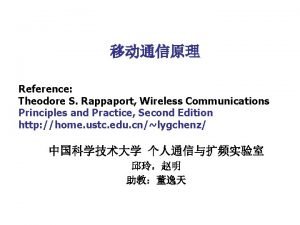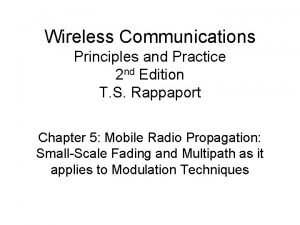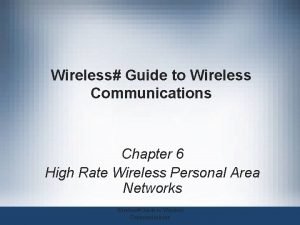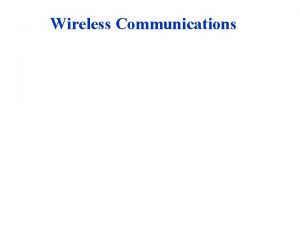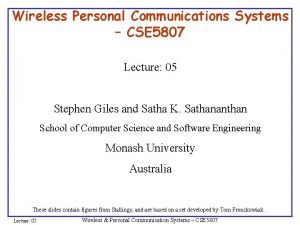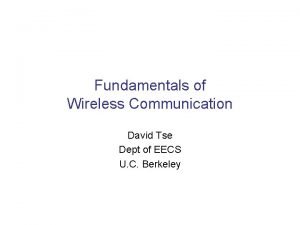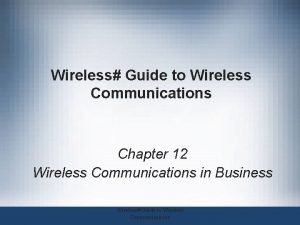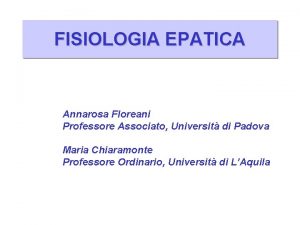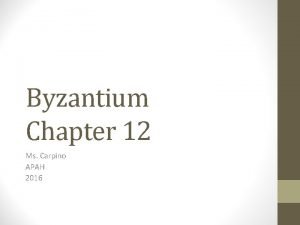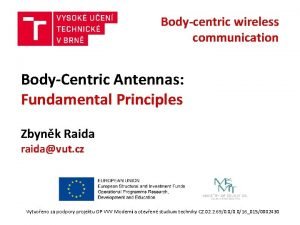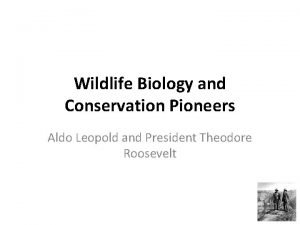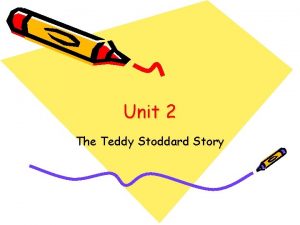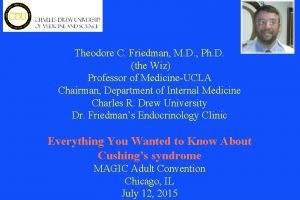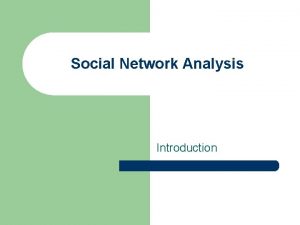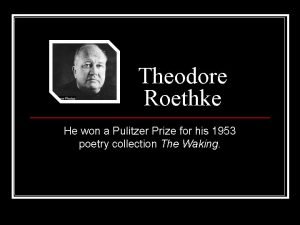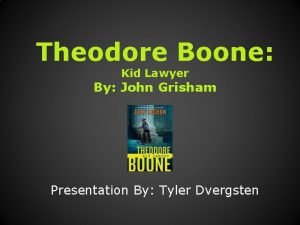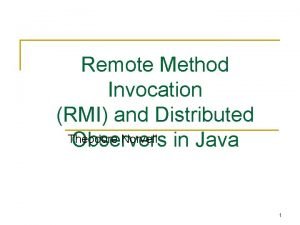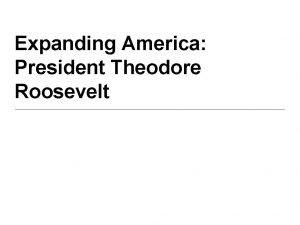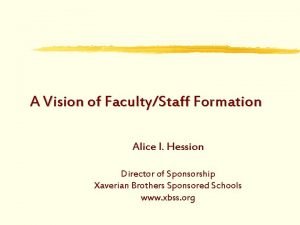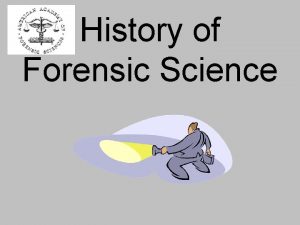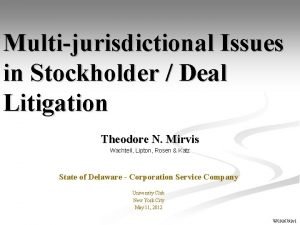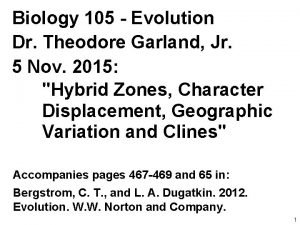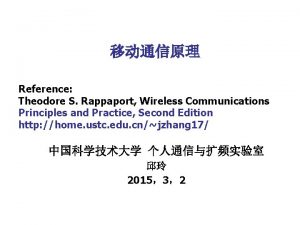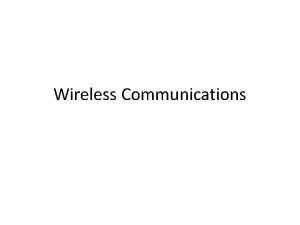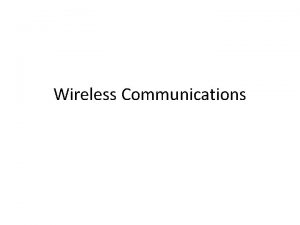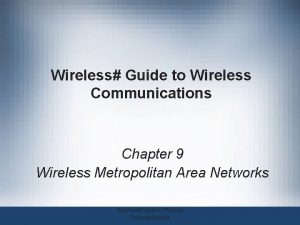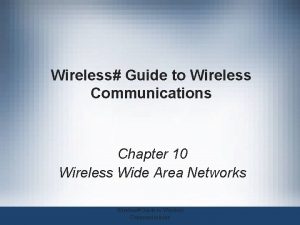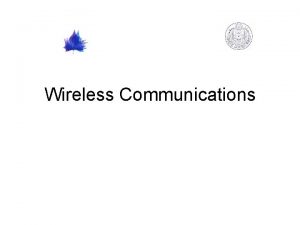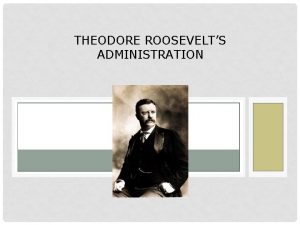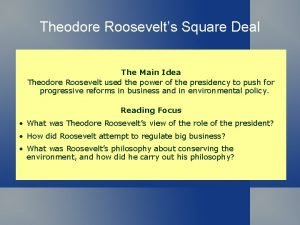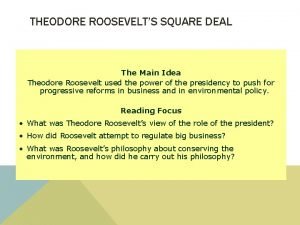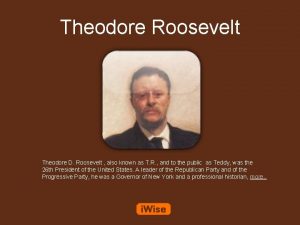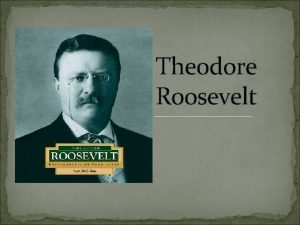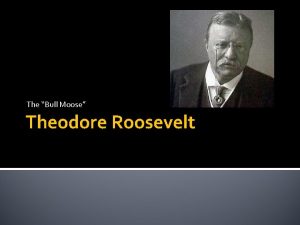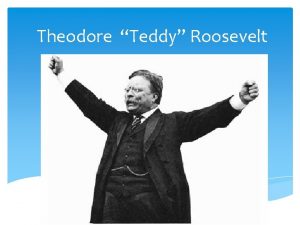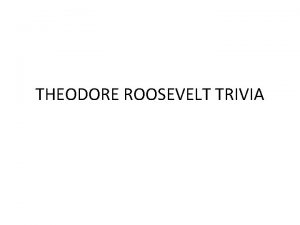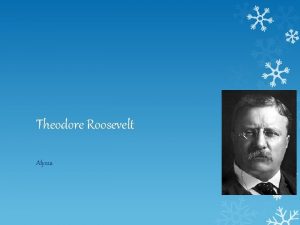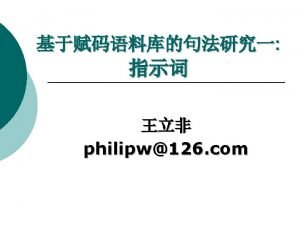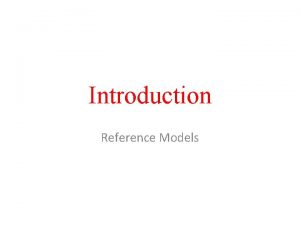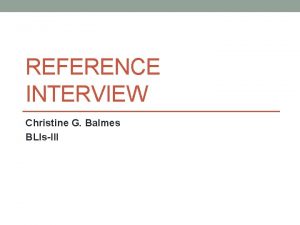Reference Theodore S Rappaport Wireless Communications Principles and




































- Slides: 36

移动通信原理 Reference: Theodore S. Rappaport, Wireless Communications Principles and Practice, Second Edition http: //home. ustc. edu. cn/~lygchenz/ 中国科学技术大学 个人通信与扩频实验室 邱玲,赵明 助教:董逸天


Contents 1. Introduction 2. Modern Wireless Systems 3. Cellular Concept 4. Mobile Radio Propagation: Large-Scale Path Loss 5. Mobile Radio Propagation: Small-Scale fading and multipath 6. Mobile Modulation Techniques 7. Equalization, Diversity, and channel coding 8. Speech coding 9. Multiple Access Techniques 10. Wireless Networking 11. Wireless Systems and Standards

Chapter 1 Introduction

Contents 1. 1 Evolution of Wireless Communication 1. 2 Wireless Communication Systems 1. 2. 1 Cellular Systems 1. 2. 2 Cordless Telephone 1. 2. 3 Wireless Access (WLL & W-LAN) 1. 2. 4 Satellite Systems 1. 3 Concept of Mobile System 1. 3. 1 Basic Concept 1. 3. 2 Call Process


A little bit of wireless history • Maxwell’s Equation published in 1865

A solution to the Maxwell’s Equation It predicted the existence of electromagnetic wave!

All in the family!

Experiments of Hertz • Hertz’s experiment to generate microwave in 1888 v Validated Maxwell’s prediction

Experiments of Hertz

Experiments of Hertz (cont. ) • A simple schematic v Feasibility of microwave communication demonstrated

The Big Step Forward from Marconi v Transmitted telegraph signals in 1890 at his home v Wireless telegraph between ships and shore in 1897 v Trans-Atlantic communication in Dec 14, 1901 from Poldhu, Cornwall (UK) to St John’s, Newfoundland, v(Is the earth round? ) From www. footprintsshoes. com/marconi. htm

The Big Step Forward from Marconi (cont. ) v. The letter “S” (Morse code …) was transmitted from a 25, 000 W station v. Jan 18, 1903, wireless telegram and a reply LONDON ENGLAND IN TAKING ADVANTAGE OF THE WONDERFUL TRIUMPH OF SCIENTIFIC RESEARCH AND INGENUITY WHICH HAS BEEN ACHIEVED IN PERFECTING A SYSTEM OF WIRELESS TELEGRAPHY I EXTEND ON BEHALF OF THE AMERICAN MOST CORDIAL GREETINGS AND GOOD WISHES TO YOU AND TO ALL THE PEOPLE OF THE BRITISH EMPIRE THEODORE ROOSEVELT WELLFLEET MASS JAN 18 1903


1. 2 Wireless Communication Systems n n n Cellular Systems Cordless Telephone Wireless Access Systems Paging System Satellite Systems

1. 2. 1 Cellular Systems



First generation mobile communication --- 1 G Analog System basic technical feature: analog technology analog circuit units Cellular structure, roaming, handover Second generation mobile communication --- 2 G Digital system basic technical feature: digital technology digital process units SIM card, light handset, high capacity Third generation mobile communication --- 3 G Smart system basic technical feature: intelligent process technology smart process units Multimedia, higher capacity, intelligent network


4 G LTE-Release 8/9: OFDM, MIMO, with a total of 32 million users (August 2012) and expectations of close to two billion users in 2018. ØLTE-A-Release 10, finalized in 2010, the possibility for transmission bandwidth beyond 20 MHz carrier aggregation, enhanced multiantenna transmission, and the introduction of relaying functionality. ØR 11 Dec. 2012, In addition to further refining some of the features introduced as part of Rel-10, Co. MP, enhanced support for heterogeneous deployments, advanced terminal receivers and for multistandard base stations supporting. R 12 June-Sept. 2014, not only increased capacity and enhanced enduser experience, Enhanced local area access, Multi-antenna enhancements, Improved support for machine-type communication (MTC), Direct device-to-device communication Ø 5 G: 系� 数据�� 支撑能力达 10 Gbps,�� 及功率效率� 4 G提 升10倍,网� 覆盖的� 位面� 吞吐率� 4 G提升25倍。 Ø


1. 2. 2 Cordless Telephone

1. 2. 3 Wireless Access Systems ---- Wireless Local Loop S-CDMA PHS IEEE 802. XX

1. 2. 4 Paging Systems

n n To provide ultra-reliable coverage Paging transmitters are located on tall buildings Small RF bandwidths (to which the noise level is proportional) are used to maximize SNR of each paging receiver Low data rates are used(6400 bps)

1. 2. 5 Satellite Systems n Properties ü Seamless coverage Large coverage area Long distance Reliable communication link Large bandwidth Large capacity n Disadventages ü Large delay (270 ms,100 ms) ü ü ü

n ü ü ü System composing Space part Ground part terminal Types Synchronous Asynchronous: middle orbit, ellipse orbit, low orbit Applications Navigation (Position, transportation…) Digital film Satellite radio, Satellite remote sensing

1. 3 Concept of Mobile Systems 1. 3. 1 Basic Concept 1. 3. 2 Call Processing

1. 3. 1 Basic Concept § Cellular Structure

n Simplex n Multiple access n MS – BSC – MSC n Link n Roaming, Handover

Some Definitions

1. 3. 2 Call Process § How a Cellular Telephone Call is Made


 Theodore s rappaport wireless communications
Theodore s rappaport wireless communications Wireless communications: principles and practice
Wireless communications: principles and practice Telecommunications, the internet, and wireless technology
Telecommunications, the internet, and wireless technology Guide to wireless communications 4th edition
Guide to wireless communications 4th edition Constrained nodes and constrained networks
Constrained nodes and constrained networks Subsea wireless communications
Subsea wireless communications Wireless personal communications
Wireless personal communications Fundamentals of wireless communication
Fundamentals of wireless communication Guide to wireless communications
Guide to wireless communications Annarosa floreani
Annarosa floreani Reference node and non reference node
Reference node and non reference node Reference node and non reference node
Reference node and non reference node Virgin and child between saints theodore and george
Virgin and child between saints theodore and george Fundamental principles of wireless communication
Fundamental principles of wireless communication Herbert stoddard
Herbert stoddard Theodore roosevelt college and career academy
Theodore roosevelt college and career academy Theodore stoddard
Theodore stoddard Artémise baltour-labranche
Artémise baltour-labranche Theodore friedman md
Theodore friedman md Théodore de samos
Théodore de samos Theodore newcomb bennington college study
Theodore newcomb bennington college study Dr theodore stern
Dr theodore stern Theodore bedell
Theodore bedell Theodore streleski where is he now
Theodore streleski where is he now What are some quotes from open house by theodore roethke
What are some quotes from open house by theodore roethke John grisham kid lawyer
John grisham kid lawyer Host 1
Host 1 Theodore roosevelt imperialist policies
Theodore roosevelt imperialist policies Theodore roosevelt
Theodore roosevelt Root cellar theodore roethke
Root cellar theodore roethke Theodore james ryken
Theodore james ryken Theodore roosevelt contribution to forensic science
Theodore roosevelt contribution to forensic science Hücre büyüdükçe yüzey alanı/hacim oranı azalır mı
Hücre büyüdükçe yüzey alanı/hacim oranı azalır mı Theodore schwann
Theodore schwann Theodore mirvis
Theodore mirvis Theodore eugene garland
Theodore eugene garland Kelompok sosial menurut theodore caplow
Kelompok sosial menurut theodore caplow
